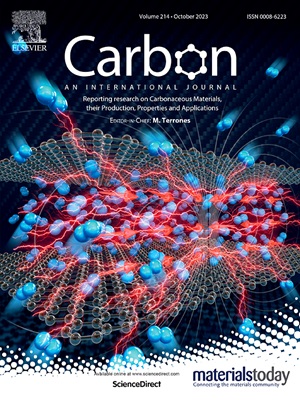层状双氢氧化物嵌入丝瓜衍生生物碳复合材料对宽带电磁波吸收和增强阻燃性能的研究
IF 10.5
2区 材料科学
Q1 CHEMISTRY, PHYSICAL
引用次数: 0
摘要
高频、大功率电子设备的日益普及,要求发展具有电磁波吸收、高导热、阻燃等特点的多功能绿色包装材料。在保持轻质和环境可持续性的同时实现这些特性仍然是一个关键的挑战。本研究以丝瓜藤废料为原料,采用直接原位生长策略制备了碳化丝瓜海绵和层状双氢氧化物(CLS@LDH)多功能绿色纳米复合材料。LDH的加入改善了阻抗匹配和界面极化。值得注意的是,最小反射损耗(RLmin)为−55.38 dB,有效吸收带宽(EAB)为7.14 GHz,填充比仅为12 wt%。此外,与环氧树脂(EP)相比,独特的复杂交织的3D生物质网络和LDH在高温下分解形成的气体保护屏障使其导热系数提高了81.36%。这一改进伴随着峰值放热率和总放热率的显著降低,分别下降了32.5%和23.1%。这项工作提出了生物质衍生碳复合材料的绿色生产方法,该材料在导热性、吸波性和阻燃性方面集成了多种功能。作为宽带电磁波吸收的绿色电子封装材料,具有广阔的应用前景。本文章由计算机程序翻译,如有差异,请以英文原文为准。
Layered double hydroxide embedded in loofah-derived biocarbon composites towards broadband electromagnetic wave absorption and enhanced flame retardancy
The rising utilization of high-frequency and high-power electronic equipments necessitates the advancement of multifunctional green packaging materials characterized by electromagnetic wave absorption, high thermal conductivity, and flame retardancy. Achieving these properties while maintaining lightness and environmental sustainability remains a critical challenge. In this study, carbonized loofah sponge and layered double hydroxides (CLS@LDH) multifunctional green nanocomposites were developed from loofah vine waste using direct in situ growth strategy. The incorporation of LDH improves impedance matching and interface polarization. It is significant that a minimum reflection loss (RLmin) of −55.38 dB, coupled with an effective absorption bandwidth (EAB) of 7.14 GHz, is achieved with a mere 12 wt% filling ratio. In addition, the unique complex interwoven 3D biomass network and the formation of a gas protection barrier by the decomposition of LDH at high temperatures contribute to 81.36 % enhanced thermal conductivity compared to that of epoxy resin (EP). This improvement is accompanied by a notable reduction in both the peak heat release rate and total heat release rate, which decline by 32.5 % and 23.1 %, respectively. This work presents green production method for biomass-derived carbon composites, and the material integrates multifunctionality in terms of thermal conductivity, wave absorption, and flame retardancy. It demonstrates considerable for utilization as green electronic packaging material for broadband electromagnetic wave absorption.
求助全文
通过发布文献求助,成功后即可免费获取论文全文。
去求助
来源期刊

Carbon
工程技术-材料科学:综合
CiteScore
20.80
自引率
7.30%
发文量
0
审稿时长
23 days
期刊介绍:
The journal Carbon is an international multidisciplinary forum for communicating scientific advances in the field of carbon materials. It reports new findings related to the formation, structure, properties, behaviors, and technological applications of carbons. Carbons are a broad class of ordered or disordered solid phases composed primarily of elemental carbon, including but not limited to carbon black, carbon fibers and filaments, carbon nanotubes, diamond and diamond-like carbon, fullerenes, glassy carbon, graphite, graphene, graphene-oxide, porous carbons, pyrolytic carbon, and other sp2 and non-sp2 hybridized carbon systems. Carbon is the companion title to the open access journal Carbon Trends. Relevant application areas for carbon materials include biology and medicine, catalysis, electronic, optoelectronic, spintronic, high-frequency, and photonic devices, energy storage and conversion systems, environmental applications and water treatment, smart materials and systems, and structural and thermal applications.
 求助内容:
求助内容: 应助结果提醒方式:
应助结果提醒方式:


